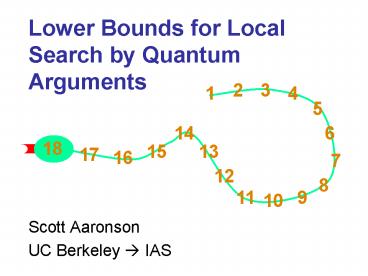Lower Bounds for Local Search by Quantum Arguments - PowerPoint PPT Presentation
1 / 21
Title:
Lower Bounds for Local Search by Quantum Arguments
Description:
... randomized, and quantum query complexities of LOCAL SEARCH polynomially related ... the quantum adversary theorem for classical randomized query complexity ... – PowerPoint PPT presentation
Number of Views:36
Avg rating:3.0/5.0
Title: Lower Bounds for Local Search by Quantum Arguments
1
Lower Bounds for Local Search by Quantum Arguments
- Scott Aaronson
- UC Berkeley ? IAS
2
Can quantum ideas help us prove new classical
results?
Quantum GenerosityGiving back because we careTM
ExamplesKerenidis de Wolf 2003Aharonov
Regev 2004
3
LOCAL SEARCH
Given a graph G(V,E) and oracle access to a
function fV?0,1,2,, find a local minimum of
fa vertex v such that f(v)?f(w) for all
neighbors w of v. Use as few queries to f as
possible
4
4
2
5
3
4
Results
First quantum lower bound for LOCAL SEARCHOn
Boolean hypercube 0,1n, any quantum algorithm
needs ?(2n/4/n) queries to find a local
min Better classical lower bound via a quantum
argument Any randomized algorithm needs
?(2n/2/n2) queries to find a local min on
0,1nPrevious bound 2n/2-o(n) (Aldous
1983)Upper bound O(2n/2?n) First randomized or
quantum lower bounds for LOCAL SEARCH on
constant-dimensional hypercubes
5
Main Open Problem
Santha Szegedy, this STOC
Are deterministic, randomized, and quantum query
complexities of LOCAL SEARCH polynomially related
for every family of graphs?
6
Motivation
- Why is optimization hard? Are local optima the
only reason? - Quantum adiabatic algorithm (Farhi et al. 2000)
What are its limitations? - Papadimitriou 2003 Can quantum computers help
solve total function problems?
PPADS PODN PPP
PLS
7
Trivial Observations
Complete Graph on N Vertices?(N) randomized
queries?(?N) quantum queries
8
Trivial Observations
Line Graph on N VerticesO(log N) deterministic
queries suffice
So interesting graphs are of intermediate
connectedness
9
Boolean Hypercube 0,1n
Aldous 1983 Any randomized algorithm needs
2n/2-o(n) queries to find local min Proof uses
complicated random walk analysis
10
How to find a local minimum in
queries (d maximum degree)
Let v be the queried vertex for which f(v) is
minimal
Follow v to a local minimum by steepest descent
Quantumly, O(N1/3d1/6) queries suffice In the
above algorithm, find v using Grover search
11
Ambainis Quantum Adversary Theorem
Given 0-inputs, 1-inputs, and function R(A,B)?0
that measures the closeness of 0-input A to
1-input B For all 0-inputs A and query locations
x, let ?(A,x) be probability that A(x)?B(x),
where B is a 1-input chosen with probability
proportional to R(A,B).Define ?(B,x) similarly.
Then the number of quantum queries needed to
separate 0- from 1-inputs w.h.p. is ?(1/p), where
12
Example Inverting a Permutation
Decide whether 1 is on left half (0-input) or
right half (1-input)
?(?,x)1
4
5
1
7
2
3
8
6
but ?(?,x)2/N
R(?,?)1 if ? is obtained from ? by a swap,
R(?,?)0 otherwise
13
We prove an analogue of the quantum adversary
theorem for classical randomized query complexity
Statement is identical, except is replaced by
Yields up to quadratically better bounde.g. ?(N)
instead of ?(?N) for permutation problem
Proof Idea Show that each query can separate
only so many input pairs
0-inputs
1-inputs
14
To apply the lower bound theorems to LOCAL
SEARCH, we use snakes
11
12
10
13
Known head vertex
9
14
Length ? ?N
18
8
15
17
16
7
3
2
4
1
6
5
Unique local minimum of f
To get a decision problem, we put an answer bit
at the local minimum
15
Given a 0-input f, how do we create a random
1-input g thats close to f?
11
12
10
13
9
14
18
8
15
17
16
7
3
2
4
1
6
5
16
Given a 0-input f, how do we create a random
1-input g thats close to f?
2
3
1
4
5
6
14
18
13
15
17
16
7
12
8
9
11
10
Starting from the pivot, generate a new tail
using (say) a random walk
17
Handwaving Argument
For all vertices v?G, either ?(f,v) or ?(g,v)
should be at most 1/?N (as in the permutation
problem)
f
g
18
The Nontrivial Stuff
Need to prevent snake tails from intersecting,
spending too much time in one part of the graph,
Solutions
(1) Generalize quantum adversary method to work
with most inputs instead of all
19
The Nontrivial Stuff
Need to prevent snake tails from intersecting,
spending too much time in one part of the graph,
Solutions
(2) Use a coordinate loop instead of a random
walk.It mixes faster and has fewer
self-intersections
20
What We Get
For Boolean hypercube 0,1n
randomized,
quantum
For d-dimensional cube N1/d?????N1/d (d?3)
randomized,
quantum
21
Conclusions
- Local optima arent the only reason optimization
is hard - Total function problems below NP, but still too
hard for quantum computers? - The Unreasonable Effectiveness of Quantum Lower
Bound Methods































